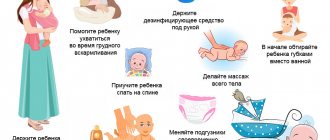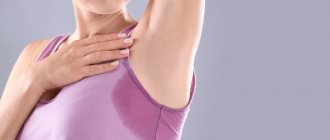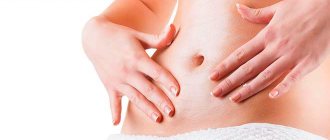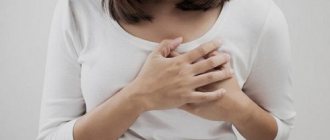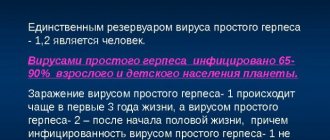Almost every woman has encountered a disease such as thrush at least once in her life. It comes in several types, and in addition to the well-known vaginal candidiasis, breast thrush occurs quite often in nursing women. This pathology is characterized by the fact that during breastfeeding the epithelial layer on the nipples is affected, as a result of which feeding the baby becomes a real challenge.
Causes of the disease
Thrush on the chest occurs when the immune defense is reduced, when the body cannot suppress the fungus.
The following factors can provoke nipple candidiasis during breastfeeding:
- injury to the nipple when feeding the baby, formation of cracks;
- depression, stress, depression in a nursing mother;
- vaginal candidiasis;
- treatment with antibacterial drugs;
- unhealthy diet with a predominance of sweets, flour, and fatty foods.
If a child becomes infected with thrush during childbirth, both need to be treated. This will prevent a circular infection when candidiasis passes from mother to newborn and vice versa.
Diagnostic procedures
To begin treatment, knowing what thrush looks like is not enough. The diagnosis needs to be confirmed. This can only be done by a doctor after receiving all the research results and collecting anamnesis. Diagnosis of the disease includes:
- General analysis of blood, urine, feces. It will help to identify the first signs of infection and inflammatory processes. All that is needed from you is to submit biological material. The laboratory assistant will tell you how to do this correctly;
- Blood chemistry. Based on the results of the analysis, the doctor will draw a conclusion about the functioning of internal organs, the strength of the immune system, etc.;
- Microscopic examination of smears taken from the nipple. In some cases, this is enough to identify the causative agent of the disease;
- Bacteriological culture of smears taken from the patient. The most accurate way to identify the causative agent of the disease.
The key to successful treatment is early diagnosis of the disease. Therefore, as soon as you notice white scales on your nipples or feel discomfort when feeding your baby, immediately go to the doctor. Do not self-medicate. Incorrect treatment aggravates the course of the disease, turning it into a chronic one.
When an accurate diagnosis is established by the doctor, he will prescribe appropriate treatment for you. During the therapeutic course, you must strictly adhere to all the doctor’s recommendations.
For informational purposes, you can study the medications that are most often prescribed if a doctor diagnoses nipple candidiasis.
What does thrush on the nipples look like?
Diagnosing mammary candidiasis is not difficult, since it has specific manifestations:
- hyperemia, nipples hurt, swell, swell;
- inflammation and dryness of the skin around the areolas;
- the surface of the nipples becomes shiny, wet, and a white coating appears on it;
- cracks, films on the chest, when touched, severe itching occurs;
- severe pain during feeding;
- decrease in the amount of milk produced.
Symptoms and signs of the disease
Nipple thrush has pronounced symptoms, so differentiating the disease is quite simple. The clinical picture characteristic of this pathology is as follows:
- painful swelling of the nipples;
- the formation of films and scaly layers on the areola;
- manifestation of a blistering rash and white plaque;
- maceration (wetting) of the skin;
- itching of varying degrees of intensity;
- soreness to touch;
- tingling and shooting deep into the chest;
- hyperemia (redness) of the adjacent skin;
- sensations of discomfort and increased sensitivity when feeding;
- burning on the surface and inside the nipples;
- pain moving to the arm or back;
- formation of cracks and erosions on the peripapillary surface;
- decreased amount of breast milk produced;
- exacerbation of vaginal candidiasis.
Despite these symptoms, the appearance of the breasts and nipples may be completely normal. At the same time, pain and other negative sensations make themselves felt only during contact with clothing, water, and directly during feeding.
A typical manifestation of thrush is the formation of a white coating
It should be noted that if these symptoms appear during lactation, then we are definitely talking about nipple thrush. Microbial eczema of the mammary glands has similar manifestations, but this disease is in no way associated with pregnancy and breastfeeding.
In rare cases, candidiasis occurs in women without lactation and even in men. This indicates a serious hormonal imbalance and/or a complete lack of hygiene.
Is it necessary to stop feeding?
With thrush, pain occurs on the breast, which impairs the flow of milk from the glands and activates mechanisms that suppress the process of milk production.
Doctors recommend stopping feeding during treatment, as the risk of infection of the baby is high. Infection of the oral cavity will lead to the fact that he will refuse the breast, and it will be painful to suck from a bottle.
How to protect your child
If a nursing mother does not want to stop feeding, all possible measures should be taken to prevent the possibility of the baby becoming infected with thrush.
What to do for this:
- Daily sterilize bottles, nipples, pacifiers - everything that the baby comes into contact with. This minimizes the risk of fungus and other infections entering the baby’s oral cavity that his still fragile immune system will not be able to cope with.
- After feeding, treat the child's mouth. To do this, use a gauze napkin, wrapped around a finger and soaked in a solution of baking soda or drops with nystatin.
- Do not use wet wipes for hygienic purposes. After using them, moisture is retained on the surface of the skin, and this is a favorable environment for fungus.
You can understand that a child has become infected with thrush by the characteristic symptoms - this is a white coating in the mouth - on the tongue, on the inside of the lips, cheeks.
Treatment methods
Treatment for breast candidiasis will vary depending on whether the disease is diagnosed in a nursing patient or in a woman who is not breastfeeding. Since thrush usually infects the baby's oral mucosa, comprehensive treatment is carried out simultaneously for mother and baby.
Antifungal gels, ointments, creams
If candida fungi only affect the skin of the chest and are not found on the genitals and oral mucosa, then you can try to overcome the disease using only local external remedies.
Early manifestations of thrush during breastfeeding are treated with local medications that suppress the activity of yeast-like fungi Candida:
- Nystatin ointment, which is applied after the baby is applied to the breast and washed off 30 minutes before the next feeding. Treatment is not interrupted for at least 14 days, even if the unpleasant symptoms quickly disappear.
- Cream, gel, solution of Candida with a pronounced antimycotic effect, containing clotrimazole. Use 2-4 times a day, but in case of severe pain - up to 6 times a day, gently removing from the breast with a damp swab before feeding.
- Nizoral cream and Mycozoral ointment based on ketoconazole are practically not absorbed into the blood, so their use in pregnant and lactating women is allowed 2 - 3 times a day. Before feeding, the product is carefully removed.
- Miconazole-based products - Mikozon, Mikogel, Monistat: twice a day until symptoms disappear, then a few more days to consolidate the antifungal effect.
Any local ointments and gels during breastfeeding are allowed to be used only after permission from the pediatrician.
In case of candidiasis of smooth skin under the breast with severe inflammation, foci of the affected epidermis are treated for 2–3 days with a 1–2% solution of “brilliant green”, in combination with zinc powder, after which antimycotic medications are used until the pathological manifestations subside: Canesten, Mifungar with oxyconazole (not for use by pregnant and lactating women), Mikospor, Bifosin with bifonazole, Zalain (sertaconazole), Pimafucin (natamycin), as well as Kanison cream - a multicomponent strong agent that simultaneously has an antifungal, antimicrobial and pronounced anti-inflammatory effect.
The duration of therapy for each type of external agent is different, but, as a rule, should last at least 2 weeks. To avoid re-development of the disease, it is advisable to treat the skin for a few more days (in some cases up to 3 weeks) after eliminating the signs of thrush.
Important! Before using ointments, you need to study in detail the medical instructions, specifics of use, contraindications, and unwanted reactions.
Drugs and tablets
It is necessary to treat breast thrush with antifungal drugs in tablets and capsules if the pathology does not go away when treating the skin with locally applied agents.
Typically, internal drug therapy is used if candidiasis affects not only the nipples, but also the mucous membrane of the vaginal canal and oral cavity.
Pediatricians usually allow nursing mothers to use: Fluconazole (Flumikon, Flucostat, Diflucan, Mikosist). The dose is determined only by the gynecologist, taking into account the severity of symptoms and the degree of damage to the skin and mucous membranes. The standard dose is 150 mg once or 50 mg for 3 days. Sometimes therapy is extended for 5–7 days.
Those patients who are not currently pregnant and are not breastfeeding their baby are prescribed the following medications:
- Rumicosis, Orungal, Irunin with itraconazole according to a 3-day regimen of 200 mg or 100 mg for 10–15 days;
- Nizoral, Mycozoral (ketoconazole) once a day 200 mg for 5 days (in tablet form it is contraindicated for pregnant women, as it causes malformations in the fetus, and for nursing mothers, since it passes into milk);
- Pimafucin (natamycin) - 4 doses per day, 100 mg for a week.
Important! If a nursing patient is ill, you should check for thrush in the baby's mouth. If foci of yeast fungi are found on the baby’s mucous membrane, the child is treated at the same time as the mother. Otherwise, there is a high risk of re-infection with Candida.
If thrush on the nipples is accompanied by vaginal candidiasis, therapy is necessary not only for the woman, but also for her intimate partner.
Nipple treatment
If nipple thrush is diagnosed, it is not enough to simply wash the breasts with warm water after each feeding. In case of illness, stronger remedies are required.
Doctors consider nipple treatment to be the most common and at the same time effective:
- 2% solution of baking soda (a teaspoon per 200 ml of boiled water).
- infusion or decoction of medicinal herbs (calendula, oak and eucalyptus leaves, chamomile flowers).
- a solution of unfiltered apple cider vinegar (a teaspoon per glass of water), which contains enzymes that inhibit the growth of fungi (you can make lotions).
Antiseptic treatment of nipples with medical products includes the use of:
- Chlorhexidine, Miramistin;
- solution and liniment 1% Sangviritrin (rinse off before feeding, has a bitter aftertaste);
- products with octenidine (MestaMidin-sens), which have the least toxicity and do not penetrate into the blood even when treating a wound surface.
If a woman feeds her baby with breast milk, pediatricians insist that pharmacological antiseptics be used only after feeding.
Healing of abrasions and cracks
In order for the treatment of cracked nipples to proceed successfully and quickly, first of all, the mother must ensure that the baby latches onto the breast correctly - grasping the areola (the pigmented circle around the nipple). The baby should not be allowed to rub the breast with his gums or bite, especially when the first teeth begin to grow. Sometimes it is impossible to gently open the baby’s gums. Then pediatricians advise to gently squeeze his nose - and the baby will release the nipple much faster.
If the instructions for an ointment or cream indicate that it must be removed before breastfeeding, it is better to wash off the product not with water, but with breast milk.
Lightweight, no-rinse nipple creams that are used either to prevent damage or at an early stage of its occurrence:
- AVENT (Philips Moisturizing Nipple) moisturizes, protects;
- Mama Comfort with aloe vera, peach, buckwheat, wheat germ oils, vitamins.
Creams and balms with natural substances and lanolin also give results for minor damage. Ideally, you should start using them already during pregnancy. Basic:
- Purelan (Purelan) from Medela or Australian Lansino (Lansinoh HPA) are natural disinfecting creams that are tasteless and odorless and do not cause allergies. They contain the purest lanolin and do not require removal from the skin before feeding. Lanolin forms a protective film, preventing the delicate skin of the nipples from drying out, reduces pain during feeding and promotes healing.
- Sanosan Mama balm (Brustwarzensalbe) with lanolin.
- Mustela nipple balm (Nursing Comfort Balm) with avocado, vitamin B5 and E, shea butter, sunflower butter, bisabolol, lupeol, lupine seed extract has anti-inflammatory properties, treats deep cracks, soothes irritated skin, and nourishes. No need to rinse off.
More effective external agents that contain medicinal components include:
- aerosol Hyposol healing antiseptic with sea buckthorn oil and methyluracil;
- Methyluracil ointment (allowed for lactation and pregnancy);
- Bepanten, and Bepanten plus (rinse off);
- D-Panthenol (lubricate after each feeding);
- Sodium usinate in fir balsam, which has antimicrobial activity.
Strong stimulators of tissue repair with increased regenerative activity are allowed to be used only after consultation with a pediatrician:
- Eplan (non-toxic, anesthetizes, kills microorganisms, softens), can be used for a healing dressing;
- Solcoseryl in the form of gel, ointment;
- Actovegin (in the same forms).
Usually, for a weeping crack, a gel is used, and after the wound dries, an ointment is used, which forms a protective fatty film on the wound surface.
Important! No creams will help if the child does not latch onto the mother's breast correctly and injures the nipple every time.
Abrasions on the nipple are not a reason to stop breastfeeding. In case of intense pain, it is advisable to temporarily stop feeding from the affected gland. If the pain is tolerable, you can alternate breastfeeding with bottle feeding so that the diseased gland is less injured.
Quick relief and healing are provided by short-term use of protective silicone or latex nipple covers that follow its anatomical shape (in combination with lanolin ointments).
They continue to feed the baby through the pads until the cracks heal (Chicco, World of Childhood, Camera, Avent, Canpol, Bebe Confort, Medela). When choosing them, you should pay attention to: size (S - small, L - standard), lack of odor, thickness (preferably thin). The pad should fit tightly to the skin, the nipple and areola should be drawn in, and milk should flow freely.
Protective pads are used only until the cracks heal. With long-term use, the baby will get used to it and may refuse to take the mother's breast (as happens when feeding through a bottle).
To give rest to damaged nipples and allow the wounds to heal, it is advisable to transfer the baby to bottle feeding for 1 - 2 days. The hole should be small so that sucking nutrition through it is more difficult than sucking from the mother's breast. In this case, babies willingly return to their “native breast” after temporary weaning from it.
Restoration of intestinal microflora
One of the most serious causes of thrush is considered to be intestinal dysbiosis, so restoration of the microflora of the digestive tract after candidiasis should be carried out actively to prevent the spread of fungi throughout the body, leading to damage to the genitourinary tract and infertility. This becomes especially important if the patient was taking antifungal medications orally.
A woman needs probiotic products with bifidobacteria and lactobacilli: Acylact, Narine, Bifidumbacterin, Linex, Normoflorin-L.
Better to use:
- multicomponent pharmaceuticals that contain several types of beneficial bacteria and important elements of immune defense: Normobact L, Trilact, Maxilact, Bifiliz, Kipacid, multiprobiotics - Simbiter 2, Probiz Femin.
- synbiotics containing both pro- and prebiotics that help live bacteria stay in the intestinal tract, such as: Bifiform, Polybacterin, Bifidumbacterin-Forte.
- genetically engineered probiotic agents – Subalin.
To eliminate intestinal dysbiosis, it is useful to temporarily limit sweets, exclude from the diet foods that activate the growth of pathogenic fungi - smoked meats, grapes, cakes, buns.
How to treat candidiasis on the chest
When treating fungus on the mammary glands, antimycotic drugs are used in the form of creams and ointments for external application.
All medications for thrush for external use are washed off the breast before feeding the baby.
In case of complications and infection in the milk ducts, it is necessary to take antifungal agents in the form of tablets. In severe cases, the woman is additionally prescribed antibiotics.
If, when treated with an antimycotic drug, improvement does not occur on the second or third day, you should consult a doctor so that he can select another remedy.
When treating nipple thrush, it is recommended to drink more green tea. It suppresses the vital activity of the fungus well and reduces its amount in the body.
Diet is required. The daily diet should not contain confectionery and flour products, fried, fatty foods, and carbonated drinks. Preference should be given to lean meats and fish, which are best boiled or steamed, fresh vegetables and unsweetened fruits.
We recommend reading the article about diet for thrush in women. From it you will learn what you can and cannot eat if you have candidiasis, what foods provoke the activity of the fungus, as well as the recommended diet for thrush in pregnant women.
Traditional recipes for breast thrush
As mentioned above, many of the known and effective drugs for fungus are contraindicated for nursing mothers. It is not surprising that a doctor may recommend resorting to traditional medicine recipes.
“Grandma’s” recipes cannot be selected independently; it is unlikely that you will be cured with their help. But as an auxiliary therapy, they will help relieve unpleasant symptoms and get rid of thrush.
A simple and popular remedy for treating various types of fungus is ordinary soda, which is found in almost every kitchen. For 0.5 liters of boiled water you will need two tsp. soda After stirring well until the soda grains are completely dissolved, the solution can be used to wash the affected areas several times a day. This will reduce itching, inflammation and redness.
A solution made from pharmaceutical chamomile (prepared according to the instructions included with the package) has a similar effect. An effective remedy for fungus is tea tree oil.
You can add a couple of drops of oil to a bath of warm water and take it for about 20 minutes. After the bath, be sure to dry your skin and apply the cream prescribed by your doctor to your chest. It is recommended to dry your breasts open after each feeding. Fungi thrive in a moist, warm environment and should be prevented from creating one.
Prevention measures
To avoid breast candidiasis during lactation, it is better to wear underwear made from natural fabrics, wash and iron them daily. After feeding the baby, you can treat the nipples with herbal decoctions with antiseptic properties. These are St. John's wort, celandine, sage, calendula, yarrow.
Other recommendations:
- Follow the rules of hygiene - wash your breasts before and after each feeding, wash your hands thoroughly with soap.
- Follow the recommended diet.
- Take any medications only after consulting a doctor and pediatrician.
- Keep your breasts dry and take air baths.
- Immediately replace breast pads that become wet with milk.
- Avoid overcooling the chest.
If thrush does appear on the nipples and areolas of the breast, you need to go to the clinic as soon as possible and undergo treatment. This will prevent the disease from becoming chronic and prevent infection of the child.
Diagnostics
The diagnosis is made based on a visual examination and questioning of the patient. Laboratory tests are also carried out. A swab is taken from the surface of the nipple and a milk sample from the woman, and the material is examined under a microscope. This allows you to detect the pathogen and determine its type. If the content of Candida fungi is high, the necessary treatment is prescribed. Unfortunately, this method is not very reliable, as it often gives a false negative result.
In addition, it is necessary to conduct a general blood test and a blood sugar test. Additionally, an immunogram may be prescribed to determine the patient’s immune status.
It is necessary to differentiate the disease from psoriasis, eczema, herpes, mastitis, which have similar symptoms. Another common cause of sore and sore nipples is the baby’s improper attachment to the breast.
Tips for mom
Thrush is not an obstacle to feeding your baby. In some cases, if the mother has very severe pain, she can express milk and feed the baby from a cup or spoon. This milk cannot be frozen.
To reduce discomfort during feeding, a woman should adhere to several rules:
- Apply the baby to the breast more often than usual, while reducing the feeding time.
- First of all, offer the baby the breast, where inflammation is less pronounced.
- Cool nipples before feeding. To do this, you can apply a piece of ice, a heating pad with ice, or a cold towel to them.
Treatment of thrush during breastfeeding
The scope for therapeutic solutions during breastfeeding (breastfeeding) is narrowed due to the threat of the “ingredients” of the drug getting into the biolactate when taken orally or the child licking them directly from the surface during local treatment. The other side of the risk is infection with pseudomycelium and spores of the baby with the subsequent development of oral candidiasis if the activity of the pathogen cannot be extinguished in time.
This will inevitably happen anyway - the causative agent of thrush is transmitted from surrounding adults to children even before the transition to adolescence. But for painless entry into the microflora, its appearance as late as possible is desirable.
Effective drugs
The optimal solution for not interrupting lactation (just wash both nipples before the next feeding if the fungus has “settled” on them) for candidiasis is local remedies - ointment, gel, cream, aqueous solution of base powder:
- with nystatin - an inexpensive (up to 80 rubles per tube of ointment of the same name) and effective, although old by medical standards, antibiotic;
- with ketoconazole, an imidazole derivative that is unsafe for the liver, like all substances in this series. The cream with it is called Nizoral (like shampoo). If it is consumed internally, the baby will definitely have to be weaned from the breast. Locally, it is safe, if you do not forget to remove its remains, it will cost around 500 rubles;
- with natamycin - another antibiotic for 300-375 rubles.
If you need a general dose, it is better to stick with Fluconazole (up to 65 rubles), Mikosist (630 rubles at most) or Diflucan (980 rubles for the same volume as the previous ones). They all have the same active ingredient – fluconazole, which is still considered the safest for humans while maintaining toxicity to fungi. The famous Ukrainian pediatrician Dr. E. Komarovsky also recommends lubricating the itching areas with miramistin, a surface antiseptic.
ethnoscience
When thrush occurs in a nursing mother, treatment is allowed not only with medications. A significant portion of people believe that folk remedies are safer in terms of side effects. In general, this is, of course, incorrect, but among those that are definitely not harmful to the child, you can focus on douching and wiping:
- homemade kefir, whey. This option is prohibited if there are deep sutures in the vagina;
- 1 tbsp. l. a mixture of 50:50 sage leaves and raspberries, brewed with a glass of boiling water for an hour in a thermos;
- a tablespoon of calendula flowers, boiled in 250 ml of boiling water, 20 minutes, over low heat.
One of the traditional remedies for persistent candidiasis is 3 tsp. St. John's wort herbs, brewed with 0.7 liters of boiling water plus fresh grated onion. It helps, but is not suitable for wiping nipples or for injuries of any scale at the application sites (it will burn, but is otherwise harmless). Its other drawback is that over time, breast milk also develops an onion taste, and the baby may refuse it.
Consequences and complications
With nipple thrush, difficulties with lactation occur. Painful sensations interfere with the normal feeding process, which can cause a woman’s milk production to decrease. An infected child's sucking reflex is reduced.
Against the background of pathology, complications such as:
- mastitis;
- blockage of the milk ducts.
As a result of candidiasis, pathogenic microorganisms enter the ducts and purulent breast diseases develop. In a baby, the disease can develop into dysbiosis or tonsillitis. Therefore, treatment must be carried out in a timely manner; this will not only help get rid of external signs, but also eliminate the disease completely.
Thrush and lactation
Breastfeeding is affected by how severe the symptoms of the disease are in mother and baby. If a child's mucous membrane is affected, it will be painful for him to eat, and he may refuse to eat. At the same time, due to hunger, the baby will behave restlessly.
When the disease manifests itself only slightly, there may be no changes in the baby’s behavior.
If the mother has severe pain, she will try to reduce the feeding time, which will have a bad effect on the baby and on milk production. In this case, the outflow of milk will be disrupted, which can lead to blockage of the milk ducts and mastitis.
Thus, lactation depends on the health of the mother. That is why thrush must be treated promptly, both in mother and baby.
ethnoscience
Thrush of the mammary glands can also be effectively treated with traditional methods, the most effective of which is considered to be treating the affected areas with a soda solution. To prepare a “healing” solution, you should dissolve a teaspoon of baking soda in one glass of warm boiled water.
The resulting product should be used to treat each breast after feeding, as well as the baby’s oral cavity using a cotton-gauze swab. After treating with a soda solution, it is not recommended to wipe your breasts with a towel; you should let it dry naturally, and then lubricate it with a moisturizer.
The development of thrush on the mammary glands is a rather unpleasant and dangerous pathology. Therefore, to prevent it, you should carefully monitor the body’s immune defense system, and also carry out prevention of vaginal candidiasis before conceiving a child.
